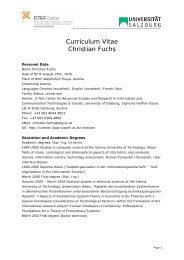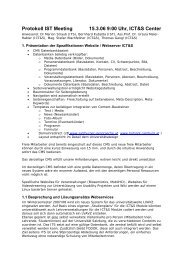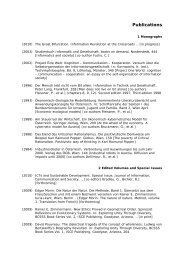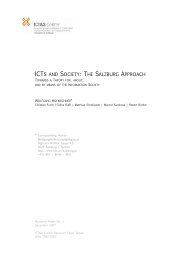CHRISTIAN FUCHS - ICT&S - Universität Salzburg
CHRISTIAN FUCHS - ICT&S - Universität Salzburg
CHRISTIAN FUCHS - ICT&S - Universität Salzburg
You also want an ePaper? Increase the reach of your titles
YUMPU automatically turns print PDFs into web optimized ePapers that Google loves.
Christian Fuchs: Social Networking Sites and the Surveillance Societyalso found that “higher online privacy concerns somewhat lowered the odds that astudent would use SNS“ (Tufekci 2008b: 556).Such research is also contradicted by other studies: Hinduja and Patchin (2008)conducted a content analysis of MySpace profiles (N=9282).“In addition, this research endeavor also revealed that almost 40% of youth settheir profile to private, thereby limiting access to their information to thoseapproved as friends. Of those that were not set to private and therefore viewableby anyone, over 81% of adolescent users included their current city while 28%also listed their school. Less than 9% of youth included their full name (38% listedtheir first name) and approximately 57% included a photograph of themselves(including over 5% wearing a swimsuit or underwear). Very few youth includedways to contact them outside of MySpace: 4% included an instant messagingscreen name, 1% included an email address, and less than one-third of 1%included a phone number. Finally, a number of youth revealed on their profilesthat they had used various illicit substances (18% used alcohol, 8% used tobacco,and less than 2% used marijuana)“ (Hinduja/Patchin 2008: 140).The authors conclude that “the vast majority of youth seem to be responsibly using theweb site“ (Hinduja/Patchin 2008: 140).3.2. Techo-optimistic Research about Integrated Social Networking SitesThis second approach questions the first one and argues that the victimizationdiscourse aims at the control of teenagers and young people by older persons and thatthe latter construct the Internet as dangerous in order to be able to exert control, take amoral conservative and puritan position, and to prohibit or limit fun and onlineexcitement. The implication is that ISNS should be autonomous spaces that empoweryoung people and help them to construct their own autonomy that they need in orderto become adults and to strengthen their personality. The techno-optimistic discourse isone of empowerment. It stresses the potential of technology for autonomy, personaldevelopment, freedom; the formation, maintenance, and deepening of communities,love, or friendships. This discourse assesses ISNS fairly positive, it mainly seesadvantages, and considers disadvantages as ideological constructs or as minor issues.The works of danah boyd represent the ideal type of this kind of research. Donath andboyd (2004) hypothesize that social networking platforms are technologies that aremore suited for forming and maintaining weak ties than strong ties. boyd (2008b)argues that teenagers are controlled in school by teachers and at home by parents andtherefore seek autonomous spaces that they need for identity formation and theirpersonal development. This would be one of the main reasons for the popularity ofSNS.“What is unique about the Internet is that it allows teens to participate inunregulated publics while located in adult-regulated physical spaces such ashomes and schools. Of course, this is precisely what makes it controversial.Parents are seeking to regulate teens behavior in this new space; and this, in turn,is motivating teens to hide“ (boyd 2008b).16









